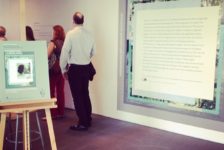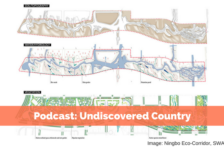Remarkable Objects, hosted by Leda Marritz, Creative Director at DeepRoot, is a new podcast about the intersection of nature and urban design. In each episode, we will hear from leaders and innovators whose work aims to influence the way we think about, design, and build the urban environment. (Lead Photo: Marquette & 2nd Avenue Busway Project by Alyn Divine for DeepRoot)
With the threat of unpredictable weather and increased rainfall intensity, officials are adapting their cities’ infrastructure to a changed climate. Similar to other parts of the country, Minnesota cities have been focusing their efforts on stormwater systems, moving away from their dependence on traditional storm sewer systems and towards a more natural approach. While the concept of accommodating stormwater management on-site through the use of green infrastructure is becoming more common, Minnesota has gone further, recognizing the important role that street trees and soils play. They are the only state that we know of that has done this, and it could completely change not only how we manage water, but also how well we sustain the urban forest.
In Episode 4, Creativity and Constraints, we hear from Randy Neprash, a civil engineer and stormwater regulatory specialist at Stantec. When nearly 160 Minnesota cities faced new mandates related to stormwater runoff, Neprash recognized that practitioners would need assistance implementing the new regulations. As a result, he established and maintains the Minnesota Cities Stormwater Coalition, which provides help to cities in implementing stormwater management techniques to meet various federal and state requirements.
The Minnesota Stormwater Manual offers guidelines, recommendations, and tools that will support the implementation of green infrastructure more uniformly across Minnesota’s cities. A number of shared resources area available, such as a calculator that quantifies the benefits of different Best Management Practices (BMPs). The calculator includes practices for green roofs, bioretention basins, infiltration basins, permeable pavement, infiltration trench/tree box, swales, filter strips and sand filters. This tool and makes it easier for practitioners to quantify the benefits of their work, and show how solutions contribute to stormwater goals.
The manual includes a section for Urban Tree BMPs to meet statewide regulatory stormwater standards. The manual formally recognizes street trees, and the soil they grow in, as a best management practice for stormwater regulations. In other words, Minnesota is combining stormwater management with urban tree canopy growth, addressing two urgent urban design needs in one regulation.
An example of an urban street tree project in Minneapolis, Minnesota. (Photo: Marquette & 2nd Avenue Busway Project by Alyn Divine for DeepRoot)
Neprash is a huge advocate of using urban trees as a stormwater management technique. Among the many benefits of trees is their ability to slow down and capture rainfall. However, planning for tree planting and planning for stormwater management are rarely connected. Pooling the planning and budgets for these two functions can help reduce overall costs and maximize the benefits of both.
In urban environments, where there is not enough open space for traditional bioretention, the use of tree trenches and tree boxes can be key to manage stormwater runoff. These tree BMPs are also an important component of urban forestry, increasing the number of trees within an urban area. Soil volume is generally a concern in these settings, as trees are often planted in constraining tree boxes that do not fair well for the growth of the tree or provide stormwater management benefits. In areas that do not have enough open space, planting techniques like suspended pavement and structural soil can be used to protect soil under pavement from compaction, creating an increased soil volume for bioretention and favorable conditions to grow large trees.
Minnesota’s coordinated approach to water quality management is widely viewed as among the best in the nation. The guidelines are leading to changes in how professionals practice, and a better understanding of stormwater BMPs in urban environments. By coordinating stormwater management with tree canopy growth, we will see much healthier and greener urban settings.
Remarkable Objects will air every-other Wednesday for the course of the eight-episode season. Check back in two weeks: I will be providing reviews of each episode, as part of the Deep Root and Land8 partnership.
Listen to the full episode here, and subscribe on Soundcloud or iTunes.
Published in Blog









![10 Billion Mouths [Video]](https://land8.com/wp-content/uploads/2018/06/michael-grove-land8x8-224x150.png)
